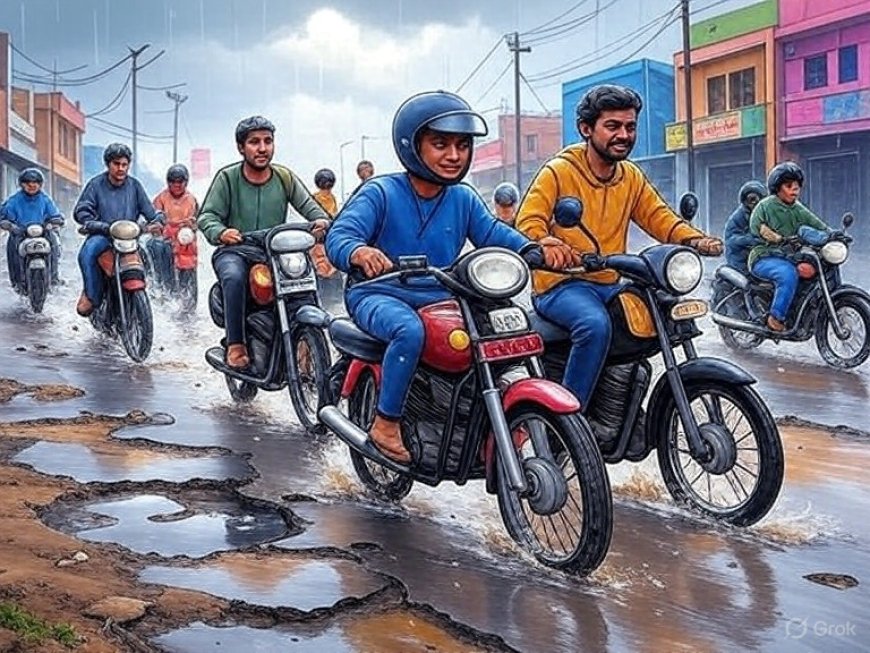Why Indian Roads Collapse During Monsoons: The Pothole Crisis Explained
Why do Indian roads disintegrate during the monsoon? Explore the science behind potholes, poor construction practices, and practical solutions to fix India's infrastructure crisis.

Introduction: The Annual Monsoon Breakdown
Each year, as monsoon clouds sweep across the Indian subcontinent, a familiar problem emerges on our roads — potholes. From national highways to residential streets, cracks, craters, and water-filled ditches turn everyday commutes into dangerous challenges. The issue is not just one of inconvenience; it results in fatal accidents, logistical delays, and enormous public expenditure.
So, why do Indian roads fail so spectacularly every rainy season?
Understanding Potholes: The Science Behind Road Failure
A pothole is a depression in the road surface caused by the combined action of water, traffic load, poor construction, and weak maintenance. Here’s a breakdown of the process:
1. Water Infiltration
Rainwater enters through existing cracks or joints in the asphalt or bitumen layer.
2. Sub-base Erosion
This water softens and erodes the underlying foundation layers — typically a compacted mix of soil, gravel, and sand.
3. Repeated Load Stress
As vehicles pass over the weakened area, the surface layer collapses, leading to chunks breaking off and forming a pothole.
4. Worsening Through Neglect
Without timely repair, potholes expand quickly — turning small cracks into deep and dangerous craters within days.
Materials and Construction Methods: What Goes Wrong in India?
In most developed countries, rigorous standards ensure roads last decades. In India, however, several systemic issues lead to rapid deterioration.
Materials Used in Indian Roads:
-
Bituminous Asphalt: Used widely due to low cost and ease of laying. However, it's vulnerable to water damage.
-
Substandard Aggregates: Many contractors use ungraded, unwashed, or even recycled debris as filler material.
-
Low-grade Bitumen: Inferior quality or adulterated bitumen fails to bond properly or resist monsoon damage.
A 2023 study by the Central Road Research Institute (CRRI) found that over 60% of urban roads failed durability tests after just two monsoon cycles.
Construction Malpractices:
-
Improper Compaction: Machines often run only once instead of the recommended 4–5 passes.
-
Skipping Curing Time: Contractors are known to open roads for traffic within hours, instead of waiting for the prescribed 24–72 hours.
-
No Drainage Design: Roads are often flat, with no gradient or side drains, causing waterlogging.
Accountability Gap: The Contractor-Politician Nexus
India's road building is governed largely by Public Works Departments (PWDs) or local municipal bodies. Many follow the Lowest Bidder (L1) tender system. This means:
-
Contractors win bids by quoting the lowest possible cost.
-
To remain profitable, they compromise on materials and labor quality.
-
There is minimal post-construction accountability, as contracts rarely include long-term maintenance clauses.
According to the CAG (Comptroller and Auditor General), thousands of crores have been lost due to delayed road repairs, inflated costs, and non-performance penalties not being enforced.
Real Consequences: The Human and Economic Cost
-
Lives Lost: In 2023 alone, over 4,000 fatalities were attributed directly to pothole-related road accidents, per NCRB data.
-
Economic Loss: Bad roads cost the economy an estimated ₹60,000 crore annually in lost productivity, fuel wastage, and vehicle damage.
-
Healthcare Burden: Hospitals in cities like Mumbai and Bengaluru report a spike in accident-related injuries during the monsoon.
What Can Be Done: Building Roads That Last
Improving Indian roads isn't just an engineering challenge — it's a governance and accountability overhaul. Here’s what can help:
1. Better Materials
-
Polymer-Modified Bitumen (PMB): More water-resistant and elastic than standard bitumen.
-
Concrete Roads: Though costlier initially, they last 3–4 times longer and withstand flooding better.
2. Proper Drainage Infrastructure
-
Roads must be designed with camber (slope) and peripheral drains to allow quick runoff.
-
Municipalities need regular desilting and unclogging of existing drains before the monsoon.
3. Technology Integration
-
Use IoT-enabled compaction meters to ensure uniformity.
-
Monitor road quality using satellite and AI-based road scanning systems.
-
Maintain digital logs of repairs for transparency and audits.
4. Policy Reforms
-
Shift from L1 contracts to Quality-cum-Cost Based Systems (QCBS).
-
Mandate third-party quality inspections and minimum 5-year performance guarantees.
-
Include citizen grievance tracking apps for real-time pothole complaints and tracking.
Global Examples India Can Learn From
-
Japan uses porous asphalt that drains water away from the road surface, preventing hydroplaning and erosion.
-
Germany mandates core sampling and third-party checks before and after every major road project.
-
Singapore leverages automated pothole detection vehicles and crowdsourced road health reports.
Conclusion: A Roadmap for Change
The pothole crisis during Indian monsoons is more than a seasonal inconvenience. It symbolizes the broken chain of accountability in public infrastructure. While monsoons are natural, road failure is man-made — a result of policy negligence, corrupt practices, and outdated methods.
If India aspires to become a $5 trillion economy, reliable road infrastructure must be a non-negotiable foundation. With the right reforms, durable materials, and enforcement, we can finally build roads that survive the storm.














